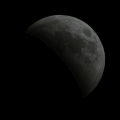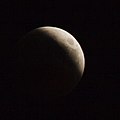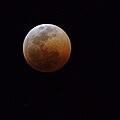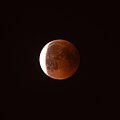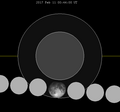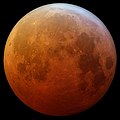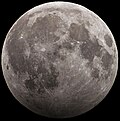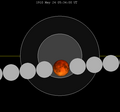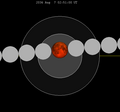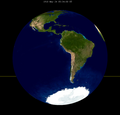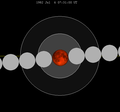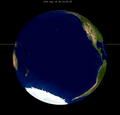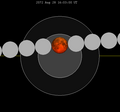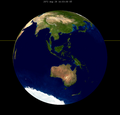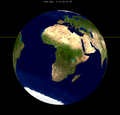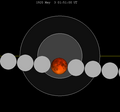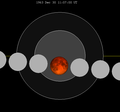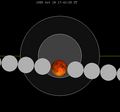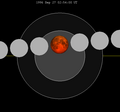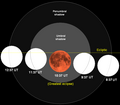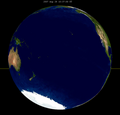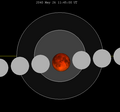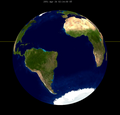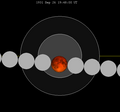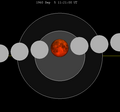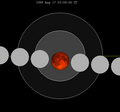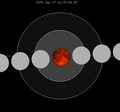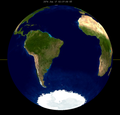Top Qs
Timeline
Chat
Perspective
July 2018 lunar eclipse
Central lunar eclipse on 27 July 2018 From Wikipedia, the free encyclopedia
Remove ads
A total lunar eclipse occurred at the Moon’s descending node of orbit on Friday, July 27, 2018,[1] with an umbral magnitude of 1.6100. It was a central lunar eclipse, in which part of the Moon passed through the center of the Earth's shadow. A lunar eclipse occurs when the Moon moves into the Earth's shadow, causing the Moon to be darkened. A total lunar eclipse occurs when the Moon's near side entirely passes into the Earth's umbral shadow. Unlike a solar eclipse, which can only be viewed from a relatively small area of the world, a lunar eclipse may be viewed from anywhere on the night side of Earth. A total lunar eclipse can last up to nearly two hours, while a total solar eclipse lasts only a few minutes at any given place, because the Moon's shadow is smaller. Occurring about 19 hours after apogee (on July 27, 2018, at 1:45 UTC), the Moon's apparent diameter was smaller.[2]
This was the first central lunar eclipse since June 15, 2011. It was also the longest total lunar eclipse of the 21st century, but not the longest in the 3rd millennium.[3] Totality lasted one hour and 42.955 minutes,[4][5][6][7] a period "just short of the theoretical limit of a lunar eclipse (one hour and 46.605 minutes)".[8] The Moon remained at least partially in Earth's shadow for three hours 54.55 minutes.[8] The longest total lunar eclipse of the 3rd millennium will occur on May 12, 2264, lasting 106 minutes and 13.2 seconds, which will be the longest total lunar eclipse since 2000, and the longest one until 3107.
The eclipse occurred when the Moon was near its maximum distance from Earth, which caused the Moon to appear smaller than normal (a phenomenon sometimes called a micromoon),[9][10] and to travel at its slowest speed in its orbit around Earth.[3]
This lunar eclipse coincided with Mars being nearly as close as possible to Earth, a concurrence that happens once every 25,000 years.[6]
Remove ads
Background
A lunar eclipse occurs when the Moon passes within Earth's umbra (shadow). As the eclipse begins, Earth's shadow first darkens the Moon slightly. Then, the Earth's shadow begins to cover part of the Moon, typically turning it a dark red-brown color (the color can vary based on atmospheric conditions). The Moon appears to be reddish because of Rayleigh scattering (the same effect that causes sunsets to appear reddish and the daytime sky to appear blue) and the refraction of that light by Earth's atmosphere into its umbra.[11]
The Moon's brightness is exaggerated within the umbral shadow.[11] The southern portion of the Moon was closest to the center of the shadow, making it the darkest, and most red in appearance.[citation needed]

Remove ads
Visibility
The eclipse was completely visible over east Africa, southern Africa, south and central Asia, seen rising over South America, west Africa, and Europe, and setting over east Asia and Australia.[12][13]
  |
 Visibility map |
Gallery
- Animation of the eclipse from Athens, Greece
- Video of the eclipse from Yekaterinburg, Russia
- Nanjing, China, 18:25 UTC
- Asunción, Paraguay 19:10 UTC
- Rethymnon, Greece 19:14 UTC
- Johannesburg, South Africa, 19:16 UTC
- Guangzhou, China, 19:20 UTC
- Limassol, Cyprus, 19:27 UTC
- Tashkent, Uzbekistan, 19:32 UTC
- Jerusalem, Israel, 19:33 UTC
- Eclipse with Mars, Fukuoka, Japan, 19:46 UTC
- Cracow, Poland, 20:05 UTC
- Chelsea, Victoria, Australia, 20:07 UTC
- Maximum from Banjarmasin, Indonesia, 20:21 UTC
- Tuen Mun, Hong Kong, 20:47 UTC
- Huittinen, Finland, 21:05 UTC
- Graz, Austria, 21:12 UTC
- Toulouse, France, 21:17 UTC
- Berlin, Germany, 21:19 UTC
- Torino, Italy, 21:19 UTC
- Hamburg, Germany, 21:23 UTC
- Brastad, Sweden, 21:24 UTC
- León, Spain, 21:27 UTC
Eclipse details
Shown below is a table displaying details about this particular lunar eclipse. It describes various parameters pertaining to this eclipse.[14]
Remove ads
Eclipse season
This eclipse is part of an eclipse season, a period, roughly every six months, when eclipses occur. Only two (or occasionally three) eclipse seasons occur each year, and each season lasts about 35 days and repeats just short of six months (173 days) later; thus two full eclipse seasons always occur each year. Either two or three eclipses happen each eclipse season. In the sequence below, each eclipse is separated by a fortnight. The first and last eclipse in this sequence is separated by one synodic month.
Remove ads
Related eclipses
Summarize
Perspective

Eclipses in 2018
- A total lunar eclipse on January 31.
- A partial solar eclipse on February 15.
- A partial solar eclipse on July 13.
- A total lunar eclipse on July 27.
- A partial solar eclipse on August 11.
Metonic
- Preceded by: Lunar eclipse of October 8, 2014
- Followed by: Lunar eclipse of May 16, 2022
Tzolkinex
- Preceded by: Lunar eclipse of June 15, 2011
- Followed by: Lunar eclipse of September 7, 2025
Half-Saros
- Preceded by: Solar eclipse of July 22, 2009
- Followed by: Solar eclipse of August 2, 2027
Tritos
- Preceded by: Lunar eclipse of August 28, 2007
- Followed by: Lunar eclipse of June 26, 2029
Lunar Saros 129
- Preceded by: Lunar eclipse of July 16, 2000
- Followed by: Lunar eclipse of August 7, 2036
Inex
- Preceded by: Lunar eclipse of August 17, 1989
- Followed by: Lunar eclipse of July 7, 2047
Triad
- Preceded by: Lunar eclipse of September 26, 1931
- Followed by: Lunar eclipse of May 28, 2105
Lunar eclipses of 2016–2020
This eclipse is a member of a semester series. An eclipse in a semester series of lunar eclipses repeats approximately every 177 days and 4 hours (a semester) at alternating nodes of the Moon's orbit.[15]
The penumbral lunar eclipses on March 23, 2016 and September 16, 2016 occur in the previous lunar year eclipse set, and the penumbral lunar eclipses on June 5, 2020 and November 30, 2020 occur in the next lunar year eclipse set.
Saros 129
This eclipse is a part of Saros series 129, repeating every 18 years, 11 days, and containing 71 events. The series started with a penumbral lunar eclipse on June 10, 1351. It contains partial eclipses from September 26, 1531 through May 11, 1892; total eclipses from May 24, 1910 through September 8, 2090; and a second set of partial eclipses from September 20, 2108 through April 26, 2469. The series ends at member 71 as a penumbral eclipse on July 24, 2613.
The longest duration of totality was produced by member 37 at 106 minutes, 24 seconds on July 16, 2000. All eclipses in this series occur at the Moon’s descending node of orbit.[16]
Eclipses are tabulated in three columns; every third eclipse in the same column is one exeligmos apart, so they all cast shadows over approximately the same parts of the Earth.
Tritos series
This eclipse is a part of a tritos cycle, repeating at alternating nodes every 135 synodic months (≈ 3986.63 days, or 11 years minus 1 month). Their appearance and longitude are irregular due to a lack of synchronization with the anomalistic month (period of perigee), but groupings of 3 tritos cycles (≈ 33 years minus 3 months) come close (≈ 434.044 anomalistic months), so eclipses are similar in these groupings.
Inex series
This eclipse is a part of the long period inex cycle, repeating at alternating nodes, every 358 synodic months (≈ 10,571.95 days, or 29 years minus 20 days). Their appearance and longitude are irregular due to a lack of synchronization with the anomalistic month (period of perigee). However, groupings of 3 inex cycles (≈ 87 years minus 2 months) comes close (≈ 1,151.02 anomalistic months), so eclipses are similar in these groupings.
Half-Saros cycle
A lunar eclipse will be preceded and followed by solar eclipses by 9 years and 5.5 days (a half saros).[18] This lunar eclipse is related to two total solar eclipses of Solar Saros 136.
Remove ads
See also
Notes
External links
Wikiwand - on
Seamless Wikipedia browsing. On steroids.
Remove ads


